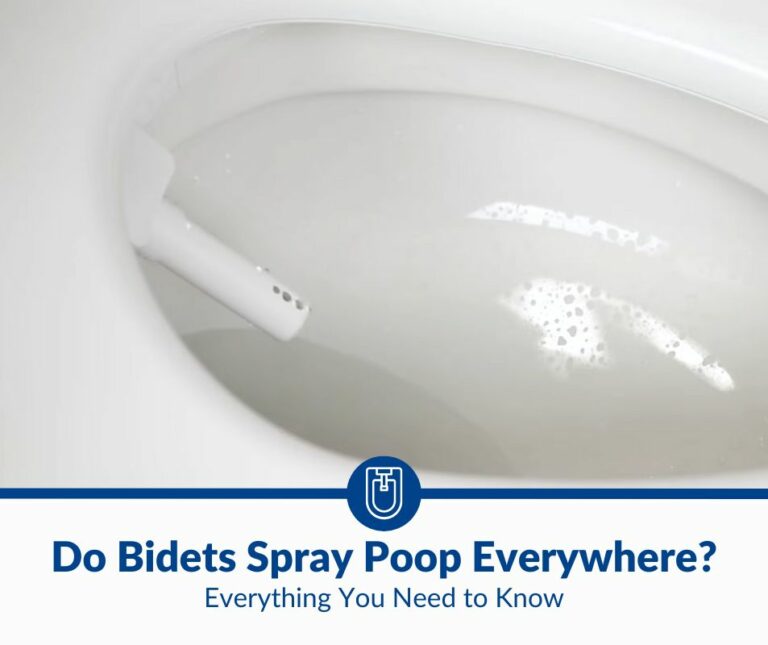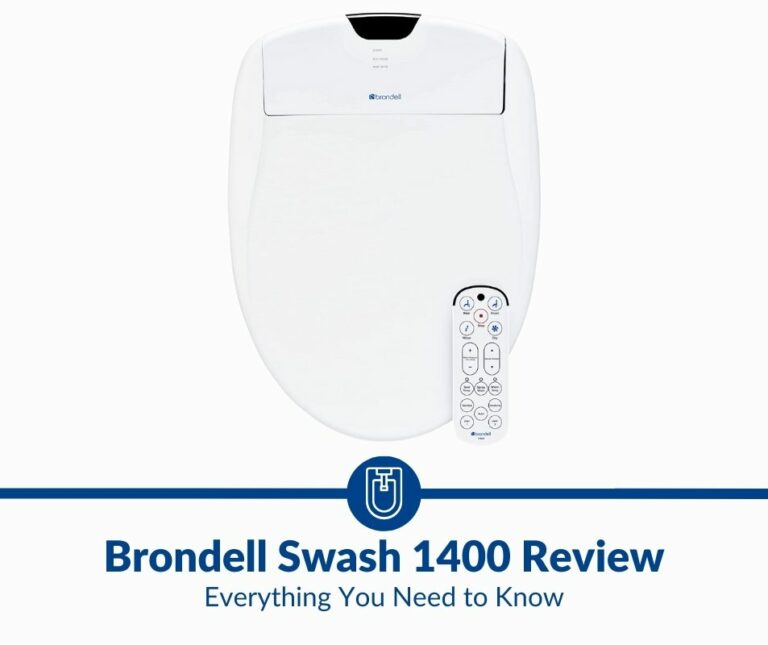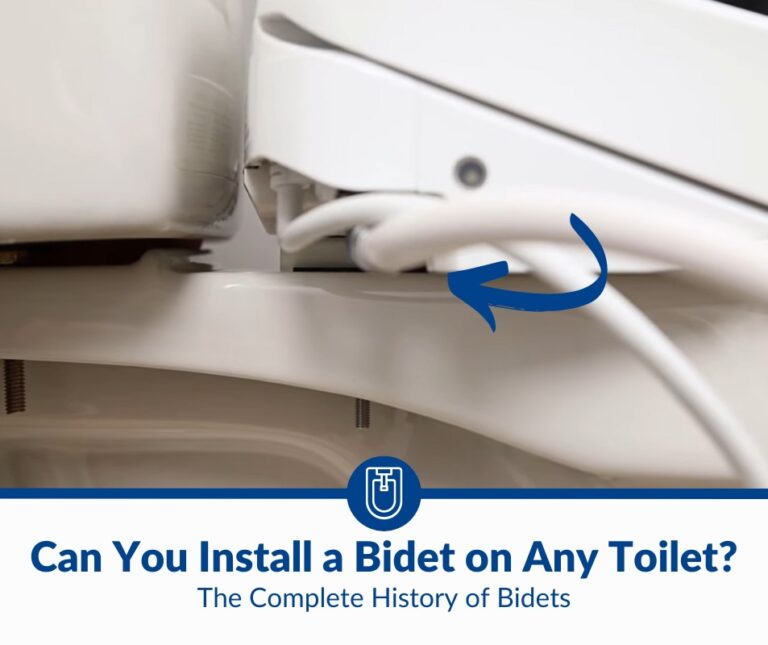How Does a Bidet Toilet Seat Work?
A bidet seat is a much more convenient and hygienic alternative to toilet paper. Unlike dry toilet paper, washing with a bidet seat is also a comforting and satiating experience. However, if you’re unfamiliar with bidet toilet seats, you may wonder how they work and if you should get one.
A bidet toilet seat is installed on the bowl using an adjustable bracket or plate screwed into the mounting holes, and it works by spraying water through a nozzle or wand that you activate when necessary. The water jet is connected to the toilet tank’s supply line.
While all bidet toilet seats are fundamentally and functionally based on the same concept, the designs and features can be distinct and sometimes unique, depending on the brand and models. Keep reading to learn everything about how contemporary bidet toilet seats work.
A Closer Look at How Bidet Toilet Seats Work
Traditional bidets are standalone fixtures in bathrooms, toilets, or water closets and resemble a sink with a faucet but at a much lower height than a washbasin. They also look like a commode. These traditional bidets aren’t installed on a regular toilet, whether as an attachment or seat.
Also, the conventional bidets used nowadays, mostly in Europe, don’t necessarily replace the use of toilet paper. People use toilet paper and supplement their cleansing routine by washing with a bidet. A contemporary bidet toilet seat is a different type of fixture in this regard.
Here are a few facts about modern bidet toilet seats, irrespective of the distinct designs or other features and the ways they function:
- A bidet toilet seat replaces the one you presently have on the toilet bowl.
- Bidet toilet seats don’t look very different from a regular toilet seat.
- Bidet toilet seats require a water connection for the nozzles, wands, etc.
All standard bidet toilet seats available today have the following components in common:
- A toilet seat with a cover or lid
- An internal water line or tube
- At least one nozzle or wand
- A bracket or plate for mounting
- Fittings, i.e., bolts, screws, etc.
- A hose for the water supply line
- A T-adapter, connector, or diverter
- Washers, O-seals, spares, etc.
Here’s how all these components combine as an integral unit for a bidet toilet seat to work as intended:
- A bidet seat with an internal water line or tube is mounted on your toilet bowl using the included bracket or plate and hardware fittings. Mounting plates may have different adjusting mechanisms. Plus, the hardware fittings might not be identical.
- Modern bidet toilet seats have a cover or lid, which may be standard or with soft closing hinges. Some bidet toilet seats have telescoping lids. These conceal the edge or ring for a flush appearance that is often desirable in stylish bathrooms.
- The internal water line or tube and the nozzle or wand are integral parts of a bidet toilet seat. You don’t need to install or tweak anything for these fundamental functions of a contemporary bidet seat on a regular or standard toilet.
- A bidet toilet seat has a water inlet port that connects to the supply line using the hose provided in the kit. The water supply line is usually the tank’s fill valve or inlet. Sometimes, people use the water supply shut-off valve for the toilet tank or the sink.
- The T-adapter, connector, or diverter with the O-seals or rubber washers are used to connect the bidet toilet seat’s hose to the water supply line. The bidet toilet seat’s kit adapter may not fit all connectors, hoses, or water supply lines.
- Once the installation is complete, you can use the bidet toilet seat by toggling the controls. These controls may be on a console attached to the bidet, with or without remote access. A simple bidet toilet seat may only have knobs or levers as regulators.
How To Use a Modern Bidet Toilet Seat
Contemporary bidet toilet seats have a control panel next to the fixture, often at the right toward the rear side. The console is already fixed to the bidet toilet seat; you don’t have to install or screw it in. Many bidet toilet seats have a remote you can use to select the desired functions.
Some bidet toilet seats with remotes may not have a console protruding outward from the side of the fixture. Instead, you may find power indicators and a few buttons on the seat itself. However, the remote is the main control panel, which is also more convenient for most people.
How you use a bidet toilet seat is subject to the exact mode of access and controls on the model you buy. However, most brands have at least 2 regulators to activate the bidet seat nozzle or wand and increase or reduce the water pressure.
Here’s how you can control both:
- Whenever you need to use a bidet toilet seat, select the cleanse or wash function on the control panel. The control panel may be a console or remote. You can choose ‘rear wash,’ for example, to activate the nozzle or wand and its jet spray.
- You can increase or reduce the water pressure of the jet spray, depending on your need or preference. If you have a knob, turn that to regulate the pressure. A remote will have buttons or a touch interface to decrease and increase the water pressure.
- Bidet toilet seats with 2 nozzles or wands will activate the one for the mode you select. For instance, selecting the rear cleanse or wash option will activate its dedicated nozzle, which typically doesn’t extend as much as the wand for anterior cleaning.
- Many contemporary bidet toilet seats have different jet or spray modes, such as oscillating and pulsating. You can select the preferred mode using the console or the remote. Such functions usually require just a turn of a knob or one touch on the console.
Bidet toilet seats have evolved since the first patented design and subsequent models made by Arnold Lewis Cohen. Today, some bidet toilet seats deliver much more than a water jet to clean after regular bowel movements for all and timely emptying of the urinary bladder for many.
Thus, how you install and use a bidet toilet seat depends on its type and the various features it offers.
Types of Bidet Toilet Seats
There are many different bidet toilet seat types, and there can be as many varieties as regular toilet seats. Most modern bidet toilet seats have backward compatibility, so they’re essentially a retrofit or upgrade option. Even if you have a special toilet with a unique configuration, you might find a compatible bidet seat.
Here are the broadest classifications of bidet toilet seats to help you pick the type you need and want:
Elongated vs. Round Bidet Toilet Seats
Most of the standard toilets in the US are either elongated or round. Hence, every manufacturer makes bidets for both elongated and round toilet bowls. The shape of the seat doesn’t have any effect on the core functions of a bidet. However, you must select the right shape or size for your toilet bowl.
Elongated toilet bowls usually measure 18 to 20 inches long (45.72 cm to 50.80 cm). A round toilet bowl is usually 16 to 18 inches long (40.64 cm to 45.72 cm). You can measure this length from the center of the toilet seat’s two bolt holes to the bowl’s front edge.
If you have a round or elongated bowl measuring 16.5 inches (41.91 cm) or 18.5 inches (~46 cm), respectively, you can select a bidet toilet seat accordingly to achieve a seamless fit. These sizes apply to both one-piece and two-piece toilet configurations. However, there will be some differences.
A one-piece skirted toilet with an attached or integrated tank may have less space behind the bolt holes for a bidet seat’s mounting plate and screws. A two-piece toilet with a detached tank may not pose a problem because there will likely be sufficient space for the mounting bracket.
In most cases, the standard one-piece and two-piece toilet configurations don’t pose a problem for bidet seats. You should still check yours so that you are sure about the compatibility of your bidet toilet seat. Also, measure the gap between the bolt or mounting holes on the bowl.
The distance or gap between the bolt holes isn’t necessarily a concern if you have a standard toilet bowl. The space between the 2 bolt holes is typically 5.5 inches (13.97 cm). Even if the gap is slightly different, most bidet toilet seats have adjustable plates, so they should fit perfectly.
Standard vs. Electric Bidet Toilet Seats
All relatively inexpensive bidet toilet seats are non-electric or standard. Electric bidet toilet seats have substantially higher prices, but they also have several valuable features, including but not limited to the following:
- Heated seat
- Hot water jet
- Warm air dryer
Most electric bidet toilet seats with these features have temperature controls for every heated function. Additionally, some brands have sensors in their bidet toilet seats. Toto Washlets, for example, have the following sensor-enabled features, depending on the model:
- Automatic flush after use
- Automatic lid open and close
- Seat sensor to activate features
The basic features are generally common in electric and standard bidet toilet seats, such as a self-cleaning nozzle or two if there are dedicated wands for anterior and posterior washing. However, electric variants tend to have many more functions, including the following:
- Air-purifier or deodorizer
- Nozzle position adjustment
- Standard or wider cleansing
Unique and Wall-Hung Bidet Toilet Seats
Standard bidet seats can fit most of the common one-piece and two-piece toilets with elongated or round bowls . However, some designs pose a compatibility issue, such as the following:
- One-piece French curve toilets with a concave tank
- Unique bowl shape or size, be it the rear or the top
- Wall-hung toilets with concealed tanks or tankless models
Curved tanks or French curve toilets may not have sufficient clearance at the back for standard bidet seats. Consider the example of Brondell bidet seats. The Brondell LE99 Swash Electronic Bidet Seat (available on Amazon.com) for elongated toilets requires at least 1.5 inches (3.81 cm) clearance at the back.
Likewise, the Brondell Swash Electronic Bidet Seat (available on Amazon.com) for round toilets also requires a minimum of 1.5 inches (3.81 cm) space behind the bolt holes and between the flat edge on either side and the base of the tank. French curve toilets with a concave tank base may not have the clearance.
Brondell’s FreshSpa and PureSpa bidet attachments require less clearance, but these variants will still need at least a 3/4-inch (~2 cm) gap for a proper fit and installation. Such attachments are not bidet toilet seats.
Unique bowl shapes and sizes are likely to be problematic if the flat surface on top or the edges are unusually broader or slender. Standard bidet toilet seats might be too small or large for such unique designs. This incompatibility issue equally applies to electric and non-electric bidets.
Wall-hung toilets with concealed tanks or tankless flushing systems may not have an accessible water supply line or a shut-off valve nearby to connect a standard bidet toilet seat. You’ll have to use another inlet, which might require a longer hose than the one included with a bidet seat.
Washlet combos of bidets and toilets from Toto are another example of a distinct configuration. The Washlet+ toilets have a hole in the bowl for you to route the power cord and water supply hose of the bidet for a concealed and seamless installation. However, these are compatible combos.
Bidet Toilet Seat Installation
Most bidet toilet seats have a straightforward installation process involving the following steps:
- Close the shut-off valve of the water supply line to the toilet tank.
- Remove your old toilet seat from the mounting holes of the bowl.
- Clean the bowl and flush the toilet to drain the water in the tank.
- Unscrew the lock nut of the hose connected to the tank’s fill valve.
- Fit the provided T-adapter to the hose and connect it to the fill valve.
- Align the T-adapter to have the diverter facing toward the bidet seat.
- Install the bidet toilet seat’s mounting bracket or plate on the bowl.
- Align and adjust the bidet toilet seat to attach it to the mounting plate.
- Use the provided bolts and screws to secure the bidet toilet seat.
- Connect the bidet toilet seat hose to the T-adapter’s diverter port.
There may be additional steps for some bidet toilet seats and other variants, such as a console or attachment.
Bidet Toilet Seats vs. Attachments
Bidet toilet seats aren’t attachments, and the fixture replaces your present toilet seat. A bidet toilet seat attachment is a console you install on the bowl. But this attachment still requires your old seat to sit atop it. Also, such attachments may not include the bolts and screws in the kit.
Bidet toilet seat attachments use adjustable brackets or mounting plates and the same bolts and screws you have for your present toilet seat. However, some attachments may have a full kit for mounting the console on the bowl.
The other differences between bidet toilet seats and attachments are the water connection and the provisions for cool and warm water lines.
Bidet Toilet Seat Water Connection
Most bidet toilet seats require one water connection, typically facilitated by a T-adapter at the tank’s fill valve. The inlet at the shut-off valve may be used with a compatible adapter if a bidet toilet seat’s hose isn’t too short. Otherwise, you need a longer hose.
Electric bidet toilet seats that dispense warm water usually have an integrated heating coil or element. Some bidets use a heating element and a small warm water tank. Those that only use a small tank may not deliver instant warm water continuously due to the limited capacity.
Unlike electric bidet toilet seats, the attachments or consoles don’t ordinarily have a heating element. If a bidet attachment has provisions for both cool and warm water, it will likely have 2 inlet ports. You can connect these ports to hot and normal water supply lines.
Using a compatible T-adapter, the cool or regular water supply line can be the tank’s inlet or the toilet’s shut-off valve. The sink’s cool water line is an alternative for concealed tanks or tankless flushing systems. A bidet attachment’s warm water inlet connects to the sink’s hot water line.
Bidet Toilet Seat Power Connection
Electric bidet toilet seats require power, a standard 120V GFCI wall outlet, or a receptacle. If you don’t have an appropriate outlet near the toilet, you can use a GFCI extension cord rated for the amperage of the bidet seat. GFCI cords with plugs for outdoor use are reliably water-resistant.
How To Choose a Compatible Bidet Toilet Seat
Generally speaking, you should consider 2 sets of criteria to choose a bidet toilet seat: compatibility and features.
Here are a few tips to help you find and select a compatible bidet toilet seat with the functions you want:
- Match the bidet seat to your toilet configuration. This could include one-piece, two-piece, curved tank, etc.
- Select an elongated or round bidet toilet seat based on the bowl you have. If you have a unique bowl shape or size, shop for a bidet toilet seat accordingly.
- Check the water supply line to your toilet tank to ensure the bidet seat’s fittings will be compatible. For instance, the T-adapter for the tank fill valve won’t fit the water line at the shut-off valve for your toilet. Also, a hard pipe for the toilet tank won’t work.
- Compare the features of standard or electric bidet toilet seats, depending on the type you want. The two types are a world apart, but even the same kind has many variants today. Apart from the features or functions, the materials can be different, too.
- Prioritize dual nozzles with self-cleaning modes and ease of installation. A bidet toilet seat with a complete set of hardware fittings is better. Also, some bidet seats have locking clasps on the mount plates and quick-release tabs. These are more convenient.
Final Thoughts
A bidet toilet seat has simple working mechanisms, and the controls are effortless. Get a bidet seat compatible with your toilet, and the turnkey installation will take minutes with flathead and Phillips screwdrivers. Most fittings are threaded lock nuts that you can tighten with your fingers.







